Study of the Changes in Optical Parameters of Diseased Apple Pulps Based on the Integrating Sphere Technique
By applying vis-NIR spectroscopy, combined with an integrating sphere technique, a method for nondestructive testing of internal lesions in apples has been developed. This work provides a theoretical basis for the nondestructive testing of apples using tissue optical parameters.
Lesions in the internal tissues of apples lead to changes in their chemical composition and physical properties, which in turn lead to changes in optical parameters. The integrating sphere method can be used to detect optical parameters by means of slice detection. Healthy apple pulps, pulps with mild lesions, and pulps with severe lesions can be cut from the same diseased apple and then measured simultaneously. The results are as follows. In diseased fruits of three pathogens, the absorption coefficient gradually increases with the appearance and aggravation of the lesion. The reduced scattering coefficient gradually decreases, and the change in the absorption coefficient changes significantly. The degree of change in the optical parameters varies, but the above trends are still obvious. This work provides a theoretical basis for the nondestructive testing of internal lesions in apples using optical parameters of their tissues in later stages.
Internal lesions of apples, such as apple mildew and browning of flesh, are not easy to identify from their appearance at the beginning of disease. Only after dissection can the lesions be seen, and internal lesions affect the sensory quality of the fruit and cause health threats to consumers. Visible-near-infrared (vis-NIR) spectroscopy is widely used, among many nondestructive testing techniques, for identifying internal lesions in apples. The traditional NIR spectroscopy method is used to establish a mathematical model between the lesion and the near-infrared spectra of apples using chemometric methods, which are associated with some challenges related to stability and adaptability (1). At present, domestic and foreign scholars and our research show that the internal qualities of fruits are closely related to the optical parameters of their tissues (2). When lesions occur inside apples, their absorption coefficient and scattering coefficient will be different from those of healthy fruits. Thus, optical parameters can be used to infer whether an apple has a lesion.
At present, the measurement methods of optical parameters of biological tissues mainly include the time resolution method, spatial resolution method, frequency domain resolution method, and integrating sphere method (3). These methods indirectly obtain the optical parameters of tissue by measuring certain parameters of the intact apple or a tissue section, such as diffuse reflectance, diffuse transmittance, and collimated transmittance, combined with specific optical transmission models and inversion algorithms. The absorption and scattering properties of the tissues are obtained separately
or simultaneously.
Table I shows the optical parameters of healthy apple pulp tissue measured by different methods. Because of differences in the spectral wavelength ranges, measurement positions, and sample preparation methods (entire sample or slice), even for the same object, the optical parameters measured by the above typical methods often have large differences.
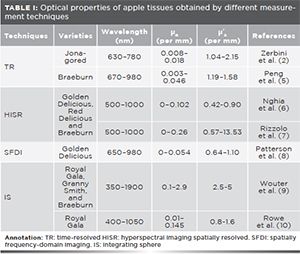
Time-resolved, spatially resolved, and frequency-domain resolved methods are generally measured by nondestructive or in vivo measurements, such as measuring an entire apple sample; however, when measuring the entire apple sample, the peel and pulp cannot be separated for measurement. Therefore, the measurement results will deviate due to the actual optical parameters of the pulp or peel. When using the integrating sphere method to measure the optical parameters of apples, a slice method is often used to measure the separation of the pulp and peel. Instead of being detected, the light leakage between the sphere and sample is supposed to be absorbed by the sample, so the measurement results have greater absorbance than the results obtained with the above methods (4), and the results presented in Table I also show this outcome.
Through the study of the optical parameters of fruit tissue, it is possible to evaluate internal qualities such as hardness, the soluble solid content of the fruit, and whether there are lesions. Cen (11) used spatial resolution hyperspectral imaging technology to measure the optical properties of Red Star peaches at 515–1000 nm to evaluate their maturity. He (12) used the measurement of µa at 900–1500 nm to establish the content of soluble solids in apples and used the µ,s measurement to build a predictive model for hardness. Zerbini (2) used other time-resolved techniques to measure the absorption coefficient of pears affected by brown rot at 710–850 nm (0.006–0.0085 per mm), which was significantly higher than the absorption coefficient of healthy tissue (0.0025–0.0052 per mm). Lu (13) used spatial resolution hyperspectral imaging technology to distinguish between normal and bruised apples and found that the effect of bruising on µ,s was larger than on µa at 500–1000 nm, indicating that µ,s is more suitable for detecting tissue damage.
None of the literature has studied the changes in optical parameters caused by different degrees of lesions in apple tissues. It is generally difficult to detect an entire apple sample to discuss differences in the optical parameters between diseased and healthy pulps as well as changes in optical parameters due to the aggravation of lesions. Therefore, in this experiment, methods of pulp slicing of different lesions in the same diseased apple were carried out, and the optical parameters of the pulps with different lesions were detected by an integrating sphere system combined with the inverse adding double (IDA) method.
Materials and Methods
Preparation of Diseased Apples
Fuji and Golden Delicious apples with good appearance, uniform quality, no damage, and no disease were purchased. Seventy-five percent alcohol was used to wipe the surface of the apples for sterilization. Strain suspensions of certain concentrations were prepared of Alternaria, Monilinia fructicola, Physalospora piricola; then, the strain suspensions were injected into apple cores from the calyx, and each apple was injected with 2 mL of 5 × 106 per mL strain suspension. The inoculated apples were placed in a humidified incubator at a temperature of 25 °C. After 7 d, the prepared pulp samples were removed.
Preparation of Measured Slices
To study the changes in the optical parameters of the diseased apple pulps, we divided the lesions of the pulp tissues into healthy pulp, pulp with mild lesions, and pulp with severe lesions. To objectively compare the changes in the optical parameters after disease, the healthy pulp, pulp with mild lesions, and pulp with severe lesions should be cut from the same diseased apple. To ensure the accuracy of the experimental results, the dicing process should limit the destruction of the physicochemical properties of the fruit; additionally, apples oxidize easily when left in the air for too long, so the measurement of the sample should be completed in the shortest possible time. The pulp slice cut by the microtome should be coated with physiological saline on both sides of the sample and secured with slides. Physiological saline has little effect on the optical parameters of the sample. It can prevent the entry of air from affecting the experimental results and protect the cells of the sample to the utmost extent. The lesion will generally become increasingly heavier from the outermost layer of the lesion area to the center of the lesion. Experiments show that it is appropriate to cut 2 mm slices for measurement (14).
Figure 1, from top to bottom, shows three sections of healthy pulp (h), pulp with mild lesions (m), and pulp with severe lesions (s) taken from the same apple sample.
Figure 1: Three slices taken from the same apple: (h) represents healthy pulp, (m) represents pulp with mild lesions, and (s) represents pulp with severe lesions.
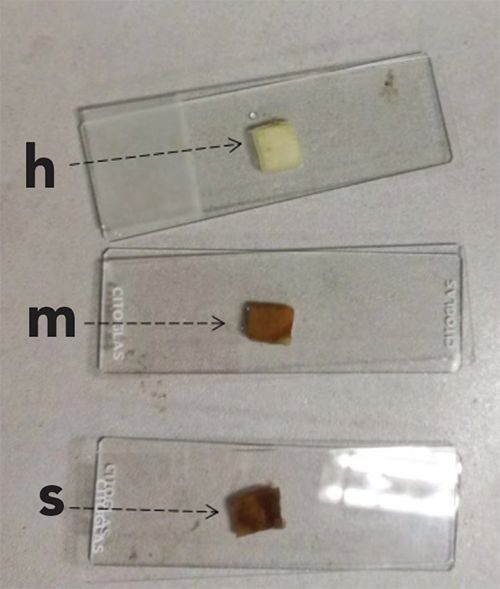
Measurement of Diffuse Transmission and Diffuse Reflection Spectra
The integrating sphere system is composed of a halogen light source, a spectral detector, a reflecting integrating sphere and a transmitting integrating sphere, with diffuse reflectance and transmittance spectra displayed on a computer (15). When measuring the diffuse reflectance R, the light inlet of the integrating sphere is opened, and the apple slice or standard plate is placed at the light outlet of the integrating sphere. The formula for reflectivity R is:

[1]
Rsp is the reflected light intensity of the sample measured by the integrating sphere, R00 is the light intensity when no objects are placed on the integrating sphere, and Rref is the light intensity when the integrating sphere is covered by the standard plate.
When measuring the transmittance T of the apple slices, the light outlet of the integrating sphere is opened, and the slices or standard plates are placed at the light inlet of the integrating sphere, and the light outlet is covered. The formula for transmission T is:

[2]
Tsp is the transmitted light intensity when the sample is placed at the inlet, Tdark is the measured light intensity when the inlet is covered, and T00 is the transmitted light intensity when the inlet is open.
Calculation of Optical Parameters
After the reflectance and transmission were measured, the obtained reflectance and transmission, as well as the given anisotropic factors and refractive index equivalent, were substituted into the inverse adding doubling (IAD) algorithm for calculation, and then the absorption coefficient and the reduced scattering coefficient were obtained (16–17).
IAD is a process of calculating optical parameters based on their reflectivity and transmittance. There is no boundary matching problem, and the calculation speed is fast. This process is widely used in measuring the optical parameters of biological tissues.
The steps of the IAD algorithm are as follows: 1) set the initial value of a group of optical parameters according to parameters such as the albedo, optical depth, and anisotropy factor; 2) calculate the reflectivity and transmission according to the initial set value of the optical parameters; 3) compare the reflectivity and transmission calculated in the previous step with the actual measured reflectivity and transmission; 4) check whether the IAD algorithm meets the preset precision requirements and output the results if they meet the requirements; otherwise, repeat the previous steps.
Results and Discussion
Optical Parameters of Healthy Pulps
A total of 35 healthy fruit samples from 18 Fuji and 17 Golden Delicious apples were measured. The optical parameters of the pulp were calculated by the IAD algorithm according to the measured diffuse reflectances and diffuse transmissions. Figure 2(a) demonstrates the absorption coefficient for the two apple types for healthy tissue from 700 to 900 nm, and Figure 2(b) shows the reduced scattering coefficient for the two apple types for healthy tissue from 700 to 900 nm. The dotted line represents Fuji apples, and the solid line represents Golden Delicious apples.
Figure 2: (a) Absorption coefficients of healthy pulp from Fuji and Golden Delicious samples. (b) Scattering coefficients of healthy pulps from Fuji and Golden Delicious samples. The dotted line represents Fuji apples, and the solid line represents Golden Delicious apples.
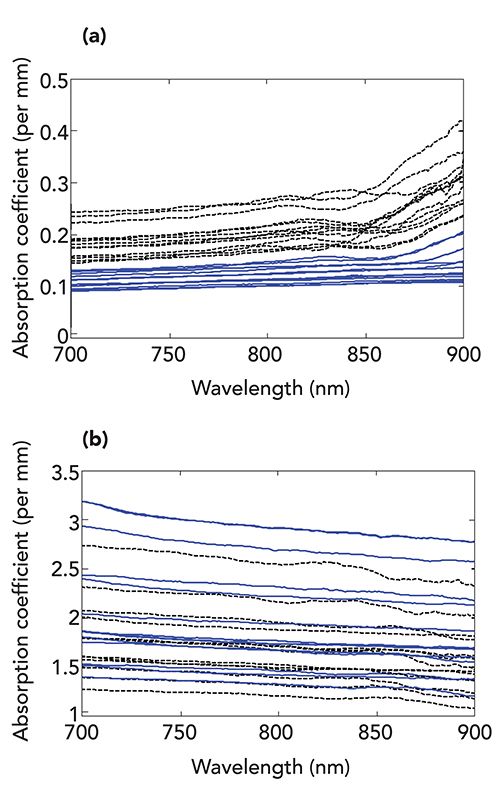
Figure 2 shows that in the selected wavelength range, the absorption coefficients of the healthy apple pulps increased slightly with increasing wavelengths, while the reduced scattering coefficient decreased gradually. At 830 nm, the absorption coefficients of the 19 Fuji apples were (0.215±0.001) per mm, the Golden Delicious absorption coefficients were (0.124±0.001) per mm, and in the tested samples, the absorption of the Fuji apples was greater than that of the Golden Delicious apples, suggesting that during the experiment, the sample content differences, such as water, sugar, and fiber, and the absorption coefficient of the Fuji apples were greater than those of Golden Delicious apples. Compared with Golden Delicious apples, Fuji apples had a more obvious upward trend after 850 nm. It may be that Fuji apples had a higher water content compared with Golden Delicious apples, which caused an absorption peak at 970 nm, so the increase was more obvious. At 700–900 nm, both in Fuji and Golden Delicious apples, the scattering coefficient decreases with increasing wavelength. The measured reduced scattering coefficient of the Fuji apples was (1.723±0.118) per mm, and the reduced scattering coefficient of Golden Delicious apples was (1.971±0.308) per mm. The healthy pulp reduced scattering coefficients between Fuji apples and Golden Delicious apples were not obviously different, and the scattering coefficient was mainly related to the microstructure of the internal organization, which shows that the internal structure of the two varieties were not significantly different. Compared with the results measured by different methods in the literature in Table I, the absorption coefficient and the reduced scattering coefficient of healthy apple pulps obtained by the experiment were all in a reasonable range.
Since the deposited strains were all injected into the core, the decay occurred from the inside to the outside; thus, pulp with deeper lesions appeared in the heart of the fruits, and the flesh with shallower lesions appeared outside. The inconsistency between the optical parameters of the core and the external healthy flesh may affect the subsequent judgment of how the optical parameters of the diseased flesh change. Figure 3 is a cross-sectional view of the inside of an apple. It can be seen that there is a clear boundary between the core of the healthy sample and the external pulp, so we must consider whether their optical parameters are also different. Table II shows the optical parameters of the cores and external healthy pulps of 4 samples of the two varieties at 830 nm.
Figure 3: A cross-section of the structural parts of the inside of an apple.

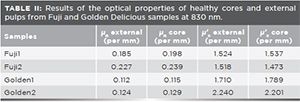
As shown in Table II, at 830 nm, the absorption coefficients of the two Fuji samples’ cores and the external healthy pulps were different by 6.50% and 4.86%, respectively. The absorption coefficients of the core pulps were greater than those of the external pulps, and the reduced scattering coefficients were different by 0.82% and 2.92%, respectively. The absorption coefficients of the two Golden Delicious apples were different by 2.43% and 4.17%, and the reduced scattering coefficients were different by 0.82% and 2.92%. Combined with the subsequent experimental results, it can be seen that the difference in optical parameters between the core and the external healthy pulp was far less than the change in optical parameters caused by pathological changes, so the influence of the difference in optical parameters between the pulp and the core on the experiment can be ignored.
Changes in the Tissue Absorption Coefficient of Apples with Different Degrees of Lesions
A total of 31 apple samples were measured and calculated, 10 of which were infected with Alternaria, 10 w of which ere infected with Monilinia fructicola, and 11 of which were infected with Physalospora piricola. The absorption coefficients at 700–900 nm were obtained. Figure 4(a) shows the absorption coefficients of a Golden Delicious apple injected with Physalospora piricola at 700–900 nm, “h” represents healthy pulp, “m” represents pulp with mild lesions, and “s” represents pulp with severe lesions. and Figure 4(b) shows the change in the absorption coefficients at 830 nm of six apple samples of two varieties that were infected with three pathogen strains. “h” represents healthy pulp, “m” represents pulp with mild lesions, and “s” represents pulp with severe lesions.
Figure 4: (a) Changes in the absorption coefficients of a sample after the occurrence of lesions in the range of 700–900 nm. (b) Changes in the absorption coefficients of different pathogens and varieties of apple after different degrees of disease at 830 nm. Note that (h) represents healthy pulp, (m) represents pulp with mild lesions, and (s) represents pulp with severe lesions.
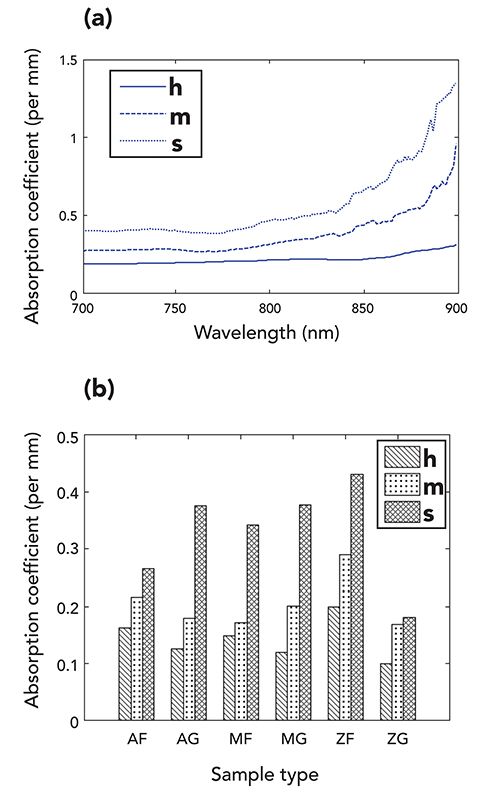
Figure 4(a) shows that in the selected wavelength range, the absorption coefficient increased with the severity of the lesion. The trend for an increase in the absorption coefficient of the lesioned pulps after 850 nm was more obvious, probably because the lesion caused additional water-stained lesions, and water accumulated in the lesion area.
The sample types “A”, “M”, and “Z” in Figure 4(b) represent Alternaria, Monilinia fructicola, and Physalospora piricola, respectively, and “F” and “G” represent Fuji apples and Golden Delicious apples, respectively; for example, “AF” represents Fuji apples that have been tempered by Alternaria. In “AF” samples, the absorption coefficients of mild and severe pulps increased by 33.37% and 63.48%, respectively, compared with the absorption coefficients of healthy pulps; in “AG” samples, the absorption coefficients increased by 41.80% and 195.82%, respectively; in “MG” samples, they increased by 68.11% and 214.52%, respectively; in “ZF”, they increased by 44.72% and 115.37%, respectively; and in “ZG”, they increased by 69.70% and 82.45%, respectively. Due to the differences between individual apples and the different lesion conditions, the degree of increase in the absorption coefficient varied, but the gradually increasing trend of the absorption coefficient was very obvious with the generation and aggravation of the lesions.
In the range of 700–900 nm, the three lesions increased the absorption coefficient, and as the degree of the lesions deepened, the absorption coefficient also increased. As the flesh rotted, sclerotia and spores grew in the pulp tissue, which made the color of the tissue deepen, and some lesions also had water accumulation, so the absorption coefficient of the pulps in the lesion areas was significantly higher than that of healthy pulps.
When some apple samples with Alternaria were tested, the absorption coefficient of the diseased fruit pulp was not significantly different from that of healthy fruit pulp but only slightly increased, which may be because the putrefaction effect of individual streptosporium samples was not significant.
Changes in the Tissue Reduced the Scattering Coefficient of Apples with Different Degrees of Lesions
In the same experiment, 31 apple samples were measured and calculated. Figure 5(a) shows the reduced scattering coefficient experimental results at 700–900 nm for a Golden Delicious apple injected with Alternaria, and Figure 5(b) is the reduced scattering coefficient at 830 nm for a total of six apple samples of two varieties putrefied by three strains.
Figure 5: (a) Changes in the scattering coefficient of a sample after the occurrence of lesions in the range of 700–900 nm. (b) Changes in the scattering coefficient of different pathogens and varieties of apples after different degrees of lesions at 830 nm. Note that (h) represents healthy pulp, (m) represents pulp with mild lesions, and (s) represents pulp with severe lesions.

It can be seen from Figure 5(a) that the reduced scattering coefficient of both the healthy pulp and the flesh with light and heavy lesions presented a slight decrease in the range of 700–900 nm.
The reduced scattering coefficient in Figure 5(b) in “AF” samples of the less diseased and heavier flesh were 44.41% and 51.48% lower, respectively, than that of the healthy pulp; in “AG” samples, the coefficient decreased by 33.39% and 84.70%, respectively; in “MF” samples, it decreased by 36.97% and 48.26%, respectively; in “MG” samples, it decreased by 60.08% and 72.38%, respectively; in “ZF” samples, it decreased by 11.78% and 47.54%, respectively; and in “ZG” samples, it decreased by 38.98% and 47.07%, respectively. In the experimental results for all samples, the reduced scattering coefficient decreased with the generation and aggravation of lesions.
The reduced scattering coefficient is mainly related to microstructure, which reflects physical properties such as firmness (16). In the two varieties of Fuji and Golden Delicious apples, all three lesions led to a reduction of the reduced scattering coefficient; additionally, aggravation of the lesion degree occurred, and the reduced scattering coefficient further decreased, which may be due to the degradation of important structural components and cell walls by bacteria in the tissues of the diseased pulp, resulting in its softening.
Conclusions
In apple tissue, the absorption coefficient is mainly related to the chemical composition of the tissue, reflecting the chemical properties of the tissue, while the reduced scattering coefficient is more reflective of the microstructure of the tissue, representing its physical properties. In this article, the integral sphere method was used to detect the sliced fruit flesh samples, and the changes in the rules of the optical parameters of diseased fruit flesh were defined: The absorption coefficient will gradually increase with the appearance and aggravation of the lesions, the reduced scattering coefficient will gradually decrease, and the change in the absorption coefficient will be more significant. In some cases, the absorption coefficient of the pulp with heavy lesions can even reach nearly three times that of the healthy pulp. These conclusions provided a theoretical basis for the later detection of diseased apples.
Although the optical parameters of pulp tissue can be qualitatively discussed, how to synthesize and improve the various measurement methods to obtain more accurate optical parameters is still an urgent problem. This work designed three kinds of lesions to discuss the changes in optical parameters. Considering the more common apple lesions, how the optical parameters change and whether the difference in the degree of changes of the optical parameters can be used to distinguish these lesions represent the future efforts of this work.
Acknowledgments
Thanks to the National Natural Science Foundation of China (NO.31772064) for its financial support and support from professor Zuojun Tan in the College of Science at HuaZhong Agricultural University, and experimental support from associate professor Xiaoqiong Zhu in the College of Plant Protection of CAU.
References
- N.C.T. Mariani, R.C. da Costa, K.M.G. de Lima, V. Nardini, L.C.C. Júnior, and G.H. de Almeida Teixeira, Food Chem.159, 458–462 (2014).
- P.E. Zerbini, M. Grassi, and R. Cubeddu et al., Postharvest Biol. Technol.25(1), 87–97 (2002).
- S.L. Jacques, Phys. Med. Biol.58(14), 5007–5008 (2013).
- C. Li, H. Zhao, Q. Wang, et al., Chin. Opt. Lett. 8(2), 173–176 (2010).
- Y.K. Peng and R.F. Lu, Postharvest Biol. Tech.48, 52–62 (2008).
- N.D.T. Nghia , C. Erkinbaev, and M. Tsuta, et al., Postharvest Biol. Tech.91, 39–48 (2014).
- A. Rizzolo, M. Vanoli , L. Spinelli, et al., Postharvest Biol. Tech.58(1), 1–12 (2010).
- M.S. Patterson, J.D. Moulton, and B.C. Wilson, et al., Appl. Opt. 30(31), 4474–4476 (1991).
- S. Wouter, M.A. Velazco-Roa, and S.N. Thennadil, et al., Appl. Opt.47(7), 908–919 (2008).
- P.I. Rowe, R. Künnemeyer, A. McGlone, S. Talele, P. Martinsen, and R. Seelye, Postharvest Biol. Tech.94, 89–96 (2014).
- H. Cen, R. Lu, F.A. Mendoza, et al. Proceedings of SPIE the International Society for Optical Engineering, 8027(4), 80270L-80270L-15 (2011).
- X. He, X. Fu, X. Rao, et al., Postharvest Biol. Tech.121, 62–70 (2016).
- R. Lu, H. Cen, M. Huang, et al., Trans. ASABE53(1), 263–269 (2010).
- S.N. Shi, Master’s thesis, Huazhong Agricultural University, HuBei, WuHan (2016).
- O. Hamdy, M. Fathy, T.A. Al-Saeed, et al., Optik 140, 1004–1009 (2017).
- H. Cen, R. Lu R , F. Mendoza, et al., Postharvest Biol. Technol.85, 30–38 (2013).
- S. Prahl, Everything I Think You Should Know about Inverse Adding-Doubling (Oregon Medical Laser Center, St. Vincent Hospital, Portland, Oregon, 2011), pp. 1–74.
Jiangtao Li, Jindan Xue, Junhui Li, and Longlian Zhao are with the College of Information and Electrical Engineering at the China Agricultural University, in Beijing, China. Li and Zhao are also with the Modern Precision Agriculture System Integration Research Key Laboratory, at the Ministry of Education, in Beijing, China. Direct correspondence to: zhaolonglian@aliyun.com
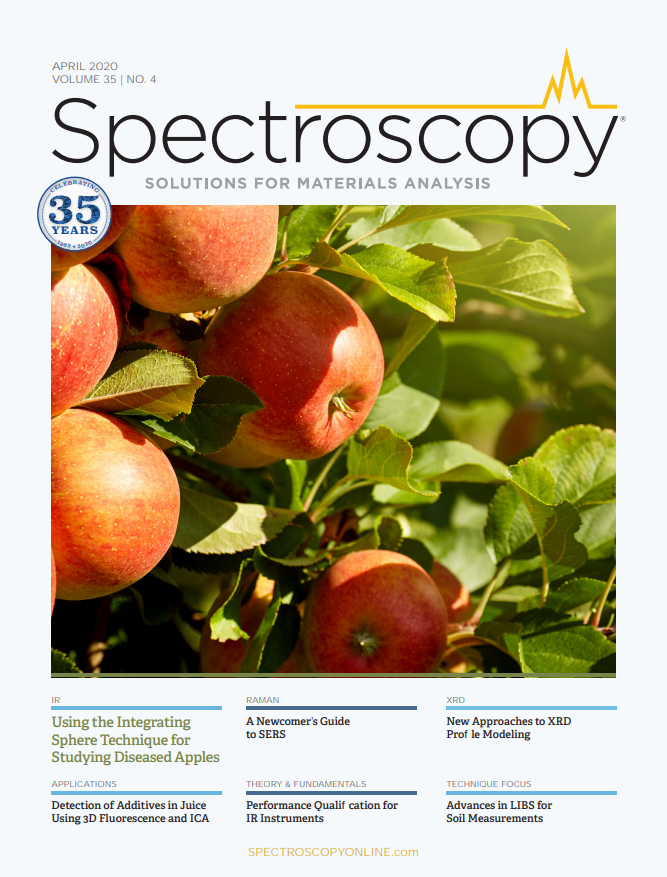
Geographical Traceability of Millet by Mid-Infrared Spectroscopy and Feature Extraction
February 13th 2025The study developed an effective mid-infrared spectroscopic identification model, combining principal component analysis (PCA) and support vector machine (SVM), to accurately determine the geographical origin of five types of millet with a recognition accuracy of up to 99.2% for the training set and 98.3% for the prediction set.
Authenticity Identification of Panax notoginseng by Terahertz Spectroscopy Combined with LS-SVM
In this article, it is explored whether THz-TDS combined with LS-SVM can be used to effectively identify the authenticity of Panax notoginseng, a traditional Chinese medicine.